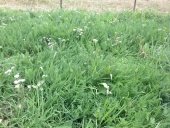Michigan, zone 5 cool/temperate
Full time farmer (pastured pork, beef, poultry &etc), excited to add fish.
I'm finally getting a pond dug this fall. I've read Desert or Paradise, Earthen ponds and a few others, saw geoff's video and a bit by ben falk. I'm just trying to get a list of ideas here that I and others can draw from (tools); then we can each figure out how to put it all together on our own property
-Deep corner- somewhere in your pond should be a deep corner for fish to hide when its warm. A lot of people say 15' or more. Do you think its an advantage to put it on the South side where it will get less sunlight?
-Shallow- a portion of your pond (up to a 1/3) should be shallow enough for cattails to filter the water. One smart farmer had the pond collecting tile runnoff and the tile dropped into a finger of cattails so it was filtered before it hit the pond
-Fingers - shoreline should be as long as possible, fingers can let you do that. Perhaps each finger could be a different biome (depths, rocks/logs, width, flow) - I need some ideas for different finger biomes
-Limestone - some people recommend dropping limestone gravel or boulders into the water to buffer ph.
-Rocks - Sepp wants rocks in his ponds; prefer shallows or north bank? Also submerged trees?
- Bubbler- windmill bubblers oxegynate
- Pump - or you can pump the water up and through a bio filter and rockbed or flowform or waterfall to aerate
- Island - habitat for ducks etc
- Floating island - shade and biofilter
-Nutrient catch - we often want to minimize animal manures into ponds due to algae overgrowth, but something has to feed the nutrient cycle if you want larger surplus harvests
-Waterfowl and fish - Polyculture!
-Grass Carp - sterile grass carp can keep weed pressure down
-Stacked ponds - ponds that flow into eachother might give more options
-Wind - design your treescape to funnel prevailing wind the long direction across the pond for free aeration
-Shade- in dry climates you want trees, in humid climates, it depends (do you want warmer or cool water) you will need some sun to keep the cycle going
You don't have to agree with all these ideas, but add more and flesh them out where you can






